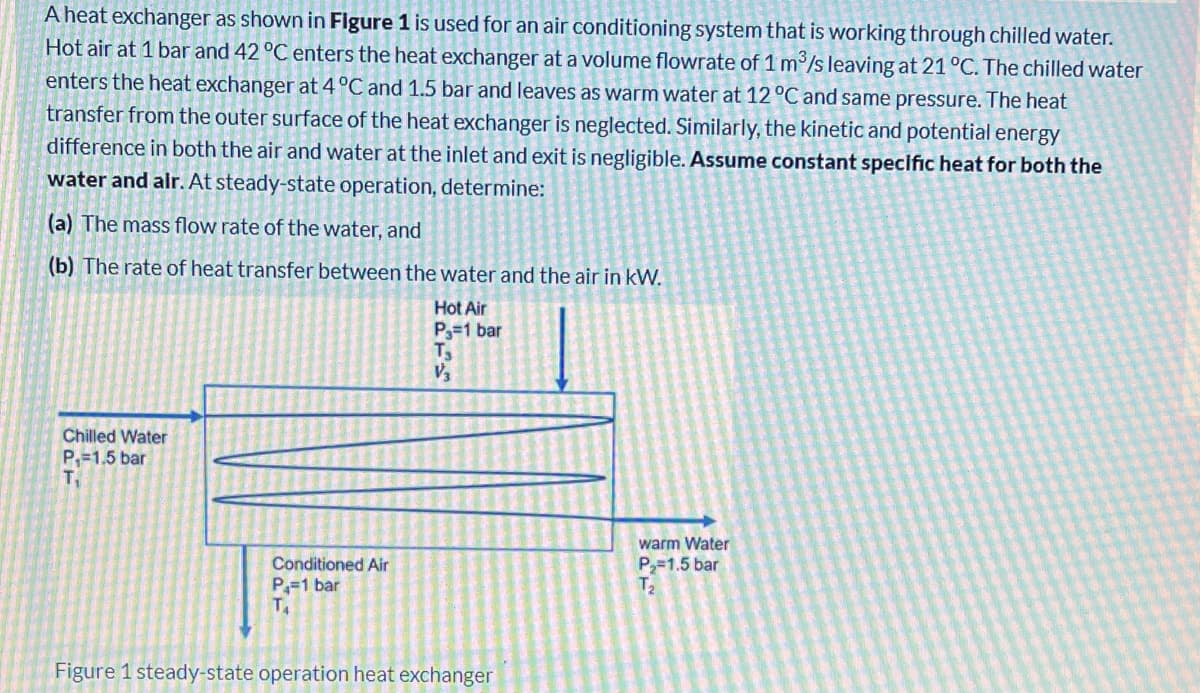A heat exchanger as shown in Flgure 1 is used for an air conditioning system that is working through chilled water. Hot air at 1 bar and 42 °C enters the heat exchanger at a volume flowrate of 1 m°/s leaving at 21 °C. The chilled water enters the heat exchanger at 4°C and 1.5 bar and leaves as warm water at 12 °C and same pressure. The heat transfer from the outer surface of the heat exchanger is neglected. Similarly, the kinetic and potential energy difference in both the air and water at the inlet and exit is negligible. Assume constant specific heat for both the water and air. At steady-state operation, determine: (a) The mass flow rate of the water, and (b) The rate of heat transfer between the water and the air in kW. Hot Air P3=1 bar Chilled Water P,=1.5 bar T, Conditioned Air P=1 bar T warm Water P2=1.5 bar T2 Figure 1 steady-state operation heat exchanger
A heat exchanger as shown in Flgure 1 is used for an air conditioning system that is working through chilled water. Hot air at 1 bar and 42 °C enters the heat exchanger at a volume flowrate of 1 m°/s leaving at 21 °C. The chilled water enters the heat exchanger at 4°C and 1.5 bar and leaves as warm water at 12 °C and same pressure. The heat transfer from the outer surface of the heat exchanger is neglected. Similarly, the kinetic and potential energy difference in both the air and water at the inlet and exit is negligible. Assume constant specific heat for both the water and air. At steady-state operation, determine: (a) The mass flow rate of the water, and (b) The rate of heat transfer between the water and the air in kW. Hot Air P3=1 bar Chilled Water P,=1.5 bar T, Conditioned Air P=1 bar T warm Water P2=1.5 bar T2 Figure 1 steady-state operation heat exchanger
Elements Of Electromagnetics
7th Edition
ISBN:9780190698614
Author:Sadiku, Matthew N. O.
Publisher:Sadiku, Matthew N. O.
ChapterMA: Math Assessment
Section: Chapter Questions
Problem 1.1MA
Related questions
Question

Transcribed Image Text:A heat exchanger as shown in Figure 1 is used for an air conditioning system that is working through chilled water.
Hot air at 1 bar and 42 °C enters the heat exchanger at a volume flowrate of 1 m /s leaving at 21 °C. The chilled water
enters the heat exchanger at 4°C and 1.5 bar and leaves as warm water at 12 °C and same pressure. The heat
transfer from the outer surface of the heat exchanger is neglected. Similarly, the kinetic and potential energy
difference in both the air and water at the inlet and exit is negligible. Assume constant specific heat for both the
water and air. At steady-state operation, determine:
(a) The mass flow rate of the water, and
(b) The rate of heat transfer between the water and the air in kW.
Hot Air
P3=1 bar
T3
V3
Chilled Water
P,=1.5 bar
Conditioned Air
P=1 bar
T
warm Water
P,=1.5 bar
T2
Figure 1 steady-state operation heat exchanger
Expert Solution
This question has been solved!
Explore an expertly crafted, step-by-step solution for a thorough understanding of key concepts.
Step by step
Solved in 4 steps

Knowledge Booster
Learn more about
Need a deep-dive on the concept behind this application? Look no further. Learn more about this topic, mechanical-engineering and related others by exploring similar questions and additional content below.Recommended textbooks for you

Elements Of Electromagnetics
Mechanical Engineering
ISBN:
9780190698614
Author:
Sadiku, Matthew N. O.
Publisher:
Oxford University Press

Mechanics of Materials (10th Edition)
Mechanical Engineering
ISBN:
9780134319650
Author:
Russell C. Hibbeler
Publisher:
PEARSON

Thermodynamics: An Engineering Approach
Mechanical Engineering
ISBN:
9781259822674
Author:
Yunus A. Cengel Dr., Michael A. Boles
Publisher:
McGraw-Hill Education

Elements Of Electromagnetics
Mechanical Engineering
ISBN:
9780190698614
Author:
Sadiku, Matthew N. O.
Publisher:
Oxford University Press

Mechanics of Materials (10th Edition)
Mechanical Engineering
ISBN:
9780134319650
Author:
Russell C. Hibbeler
Publisher:
PEARSON

Thermodynamics: An Engineering Approach
Mechanical Engineering
ISBN:
9781259822674
Author:
Yunus A. Cengel Dr., Michael A. Boles
Publisher:
McGraw-Hill Education

Control Systems Engineering
Mechanical Engineering
ISBN:
9781118170519
Author:
Norman S. Nise
Publisher:
WILEY

Mechanics of Materials (MindTap Course List)
Mechanical Engineering
ISBN:
9781337093347
Author:
Barry J. Goodno, James M. Gere
Publisher:
Cengage Learning

Engineering Mechanics: Statics
Mechanical Engineering
ISBN:
9781118807330
Author:
James L. Meriam, L. G. Kraige, J. N. Bolton
Publisher:
WILEY